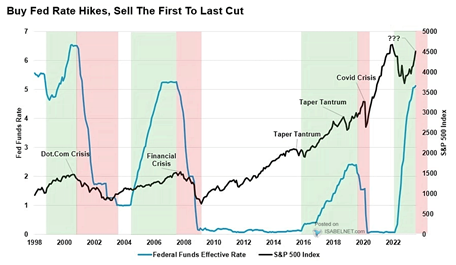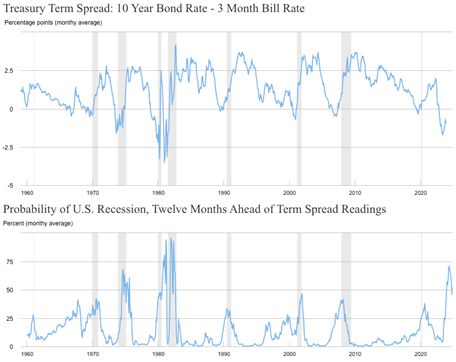It was as if sunlight finally peered through a cloudy day.
Last week, Federal Reserve Chair Jerome Powell gave investors the news they’ve been waiting all year for…
Interest rate cuts are on the horizon.
Wall Street went berserk. Both the Nasdaq and the S&P 500 rose 1.4% in short order and the Dow Jones Industrial Average closed above 37,000 points for the first time ever.
It seemed like we were finally out of the doldrums of endless high inflation and “higher for longer” fed fund rates.
But as famous ESPN college football analyst Lee Corso would say after a fellow analyst made a bad pick… “Not so fast, my friend.”
Today, I’m going to show you why we may not be out of the woods just yet. And certain data suggests rate cuts aren’t the fix-all we’re looking for.
We’re Forgetting About a Recession
Now, I’m not a doom-and-gloom kind of guy. I try to be more in the “glass half full” group.
While all of the talk in 2023 has been about inflation and interest rates, we are forgetting that a recession is not out of the question.
By definition, a recession is a prolonged and widespread downturn in economic conditions. Negative gross domestic product, rising unemployment, falling retail sales and cutbacks in consumer and business activities are all characteristics of a recession.
We saw it following the dot-com crisis of the early 2000s, the financial crisis in 2008 and to some extent after the COVID pandemic in 2020.
Higher interest rates and the cost of goods due to inflation force us to be stricter with our budget, only buying goods we need or looking for discounts on more frivolous items. It also keeps hiring tight, as bringing on new employees is a costly endeavor.
We relish rate cuts because we have jobs and some money in the bank. But if you have lost your job or slowed down your spending, it paints an entirely different picture.
After some digging, I found research that suggests 2024 may be less Mona Lisa and more Picasso.
Fed Data Suggests Recession Fears Are Still Legit
The potential for three rate cuts in 2024 is good news for investors. But the stock market is not the economy.
Unemployment rose to 3.7% in November — up from 3.6% the same time a year ago.
Interest rates are still high … which impacts the ability to borrow.
Student loan payments are also back … another pain point for the American consumer.
But we need only look at the Fed’s own data to tell us that the risk of a recession is high. And it has a lot to do with the prognosis of future rate cuts:
This chart shows the slope of the yield curve between the 10-year Treasury and the three-month Treasury — aka the difference between the rates of each.
It also shows the probability of a recession ahead of those readings.
Since 1960, every recession has started with a rise in the curve followed by a sharp drop.
As you can see, the spread in the top chart has started to drop and further rate cuts from the Fed will push that spread lower.
Let’s look at it a different way:

This chart shows the fed funds rate as a blue line and the S&P 500 as a black line.
The red on the chart indicates a recession.
Since 1998, every time the Fed cut rates, a recession followed.
We can assume that if the Fed decides to cut rates in 2024, a recession in the U.S. is likely shortly after that.
It all means that while the market can revel in the potential for rate cuts, it is those very cuts that could create an economic downturn in the next year.
To avoid this, the Fed could be dovish (aka more accommodative) in its language but remain somewhat hawkish (aka tight) in its actions.
As we saw last week, the market loves when Powell says what it wants to hear, not necessarily if he follows through…
Stay Tuned: What’s Next for Housing
As interest rates rose, the housing market got tighter and tighter in 2023.
Now, future rate cuts should provide some relief. And that’s a good sign for certain housing stocks.
Chad Stone, our managing editor, will explore what’s on the horizon for housing and how certain related stocks look within our proprietary Green Zone Power Ratings system.
Until then…
Safe trading,

Matt Clark, CMSA®
Chief Research Analyst, Money & Markets






